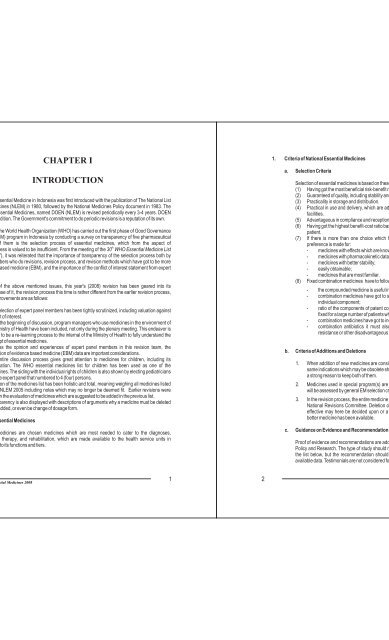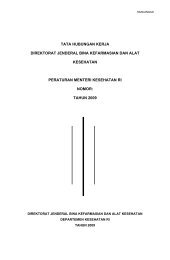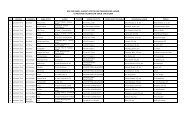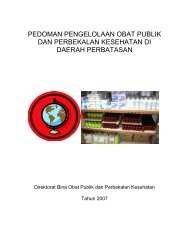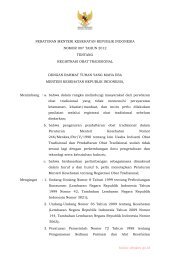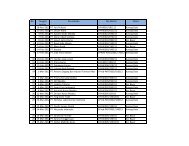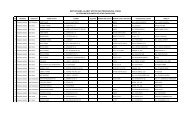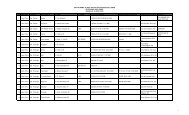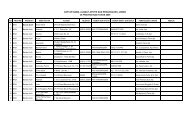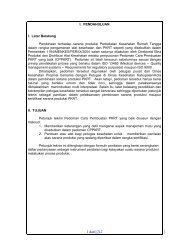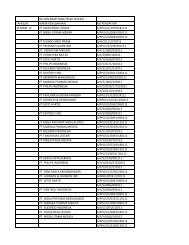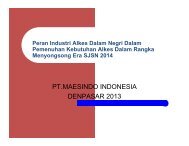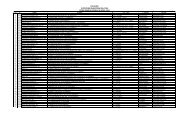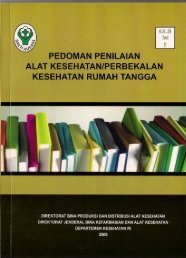CHAPTER IINTRODUCTIONential Medicine in Indonesia was first introduced with the publication <strong>of</strong> The National Listines (NLEM) in 1980, followed by the National Medicines Policy document in 1983. Thesential Medicines, named DOEN (NLEM) is revised periodically every 3-4 years. DOENdition. The Government's commitment to do periodic revisions is a reputation <strong>of</strong> its own.e World Health Organization (WHO) has carried out the first phase <strong>of</strong> Good GovernanceM) program in Indonesia by conducting a survey on transparency <strong>of</strong> five pharmaceuticalthem is the selection process <strong>of</strong> essential medicines, which from the aspect <strong>of</strong>thess is valued to be insufficient. From the meeting <strong>of</strong> the 30 WHO Essential Medicine List), it was reiterated that the importance <strong>of</strong> transparency <strong>of</strong> the selection process both byers who do revisions, revision process, and revision methods which have got to be moresed medicine (EBM), and the importance <strong>of</strong> the conflict <strong>of</strong> interest statement from expertf the above mentioned issues, this year's (<strong>2008</strong>) revision has been geared into itsse <strong>of</strong> it, the revision process this time is rather different from the earlier revision process,ovements are as follows:lection <strong>of</strong> expert panel members has been tightly scrutinized, including valuation againstt <strong>of</strong> interest.he beginning <strong>of</strong> discussion, program managers who use medicines in the environment <strong>of</strong>istry <strong>of</strong> Health have been included, not only during the plenary meeting. This endeavor isto be a re-learning process to the internal <strong>of</strong> the Ministry <strong>of</strong> Health to fully understand thet <strong>of</strong> essential medicines.s the opinion and experiences <strong>of</strong> expert panel members in this revision team, theion <strong>of</strong> evidence based medicine (EBM) data are important considerations.tire discussion process gives great attention to medicines for children, including itsation. The WHO essential medicines list for children has been used as one <strong>of</strong> thenes. The siding with the individual rights <strong>of</strong> children is also shown by electing pediatriciansexpert panel that numbered to 4 (four) persons.n <strong>of</strong> the medicines list has been holistic and total, meaning weighing all medicines listedLEM 2005 including notes which may no longer be deemed fit. Earlier revisions werethe evaluation <strong>of</strong> medicines which are suggested to be added in the previous list.arency is also displayed with descriptions <strong>of</strong> arguments why a medicine must be deleteddded, or even be change <strong>of</strong> dosage form.ential Medicinesedicines are chosen medicines which are most needed to cater to the diagnoses,therapy, and rehabilitation, which are made available to the health service units ino its functions and tiers.1. Criteria <strong>of</strong> National Essential Medicinesa. Selection CriteriaSelection <strong>of</strong> essential medicines is based on these(1) Having got the most beneficial risk-benefit ra(2) Guaranteed <strong>of</strong> quality, including stability and(3) Practicality in storage and distribution.(4) Practical in use and delivery, which are adfacilities.(5) Advantageous in compliance and reception(6) Having got the highest benefit-cost ratio baspatient.(7) If there is more than one choice which hpreference is made for:- medicines with effects which are know- medicines with pharmacokinetic data- medicines with better stability;- easily obtainable;- medicines that are most familiar.(8) Fixed combination medicines have to follow- the compounded medicine is useful in- combination medicines have got to sindividual component;- ratio <strong>of</strong> the components <strong>of</strong> patent comfixed for a large number <strong>of</strong> patients wh- combination medicines have got to inc- combination antibiotics it must alsoresistance or other disadvantageous eb. Criteria <strong>of</strong> Additions and Deletions1. When addition <strong>of</strong> new medicines are considsame indications which may be obsolete sha strong reason to keep both <strong>of</strong> them.2. Medicines used in special program(s) arewill be assessed by general EM selection cr3. In the revision process, the entire medicineNational Revisions Committee. Deletion oeffective may here be decided upon or abetter medicine has been available.c. Guidance on Evidence and RecommendationPro<strong>of</strong> <strong>of</strong> evidence and recommendations are adoPolicy and Research. The type <strong>of</strong> study should rethe list below, but the recommendation shouldavailable data. Testimonials are not considered fotial Medicines <strong>2008</strong>12
TATEMENTS OF EVIDENCEc. Hospital FormularyabData are obtained from meta-analysis <strong>of</strong> randomized, controlled clinical trials.Data are obtained from at least one randomized, controlled clinical trial.Data are obtained from at least one non-randomized and well designed clinical trial.Data are obtained from at least one quasi-experiment <strong>of</strong> another type <strong>of</strong> study that iswell designed.A Hospital Formulary is a list <strong>of</strong> medicines whicphysicians and their inherent (medicine) inforconcerned. A National Hospital Formulary is wCommittee based on NLEM and elaborated upoproven effective which are needed by specialties<strong>of</strong> a Hospital Formulary has to be based on therapHospital Formulary must be monitored and its rerevision so as to keep up with advancements <strong>of</strong> scIData are obtained from descriptive study that is well designed, like comparative study,correlation study, and case study.Data are obtained from reports or opinion <strong>of</strong> expert panels.ation <strong>of</strong> Concept <strong>of</strong> Essential Medicinesial medicines are the most basic medicines which are needed to cater for health services.r than listed NLEM medicines are needed, a (Hospital) Formulary or another limitede list may be instituted.EM may also be expanded into other documents as the needs arise.ational List <strong>of</strong> Essential Medicines (NLEM)ational List <strong>of</strong> Essential Medicines consists <strong>of</strong> selected, most needed medicines andade to be available at health services units in accordance with its functionality and itsvels. NLEM are a national minimum standard to health services.plementation <strong>of</strong> NLEM is meant to increase the efficacy, safety, rational use, andedicine management which altogether increase efficiency <strong>of</strong> available cost, which in turnxtends coverage and increase average quality <strong>of</strong> medicine prescriptions. Application <strong>of</strong>is National Essential Medicines Policy must be done consistently, and continuously at allvels <strong>of</strong> health services units.edicine dosage-form and strength, such as tablets, syrups, injections, and other forms,nit strength, dose, and size <strong>of</strong> package indicated in the NLEM are binding, in order toreate standards. Sizes <strong>of</strong> packaging for each health service unit are based on logisticsfficiency while distribution is related with common usage.herapeutic Guidelinesherapeutic Guidelines should be systematically structured to help physicians to make aorrect diagnosis and optimal medication for a certain kind <strong>of</strong> disease. Guidelines <strong>of</strong>edication should be suited for every level <strong>of</strong> health services units, such as guidelines inasic medication at Public Health Center and guidelines in diagnosis and therapy at localospitals.herapeutic Guidelines consist <strong>of</strong> information about all kinds <strong>of</strong> diseases, especiallyicknesses which are occurring frequently - with their respective complaints - andformation about dosage form, unit strength, dose <strong>of</strong> medicines and length <strong>of</strong> time <strong>of</strong>edication.d. Specialists' FormularySpecialists' Formularies are books which arinformation on medicines needed by certain speccare with special disease indications.Specialists' Formularies are written to increase ctheir hospital formulary, that has been ranked vemay have many sub-specializations, for examplea specialization that has got many sub-specializacan be made for Obstetrics and Gynecology. Tinvolve specialist pr<strong>of</strong>essional association winvolvement and active participation <strong>of</strong> specialistare part <strong>of</strong> the association, so that rational medicine. Indonesian National Medicine InformationNational medicine information consists <strong>of</strong> medipresented briefly, are relevant to physicians' needworkers. The National Indonesian Medicine InfHealth to guarantee objectivity, completenesmedicines that are covers indications, side-efimportant information which are most important fwas based on more scientific data, related to bene3. Management and Medicine UseTo improve rational medicine use, the use <strong>of</strong> essentialfollow treatment guidelines and proper medicine managEffective medicine management is required to guarantand quantities while fulfilling quality standards. Importaas follows:- Limitation <strong>of</strong> numbers and kinds <strong>of</strong> medicines basgeneric names, with a correct selection process;- Bulk purchasing should be applied;- Competitive, transparent purchases;- Audit system and reporting from management reptial Medicines <strong>2008</strong>34
- Page 1 and 2: 651.1IndPNATIONAL LIST of ESSENTIAL
- Page 3 and 4: MINISTRY of HEALTHREPUBLIC of INDON
- Page 5 and 6: THE MINISTER OF HEALTHOF THE REPUBL
- Page 7: CHAPTER IINTRODUCTION
- Page 11 and 12: d Medicinesns in the form of money
- Page 13 and 14: (d)(e)Signing a letter of consent,
- Page 15 and 16: tological Medicinesedicines were de
- Page 17 and 18: CHAPTER IIAL LIST OF ESSENTIAL MEDI
- Page 19 and 20: EUTICNERICINN)DOSAGE FORMRESTRICTIO
- Page 21 and 22: EUTICNERICINN)DOSAGE FORMRESTRICTIO
- Page 23 and 24: EUTICNERICINN)DOSAGE FORMRESTRICTIO
- Page 25 and 26: EUTICNERICINN)DOSAGE FORMRESTRICTIO
- Page 27 and 28: EUTICNERICINN)DOSAGE FORMRESTRICTIO
- Page 29 and 30: EUTICNERICINN)DOSAGE FORMRESTRICTIO
- Page 31 and 32: EUTICNERICINN)DOSAGE FORMRESTRICTIO
- Page 33 and 34: EUTICNERICINN)DOSAGE FORMRESTRICTIO
- Page 35 and 36: EUTICNERICINN)DOSAGE FORMRESTRICTIO
- Page 37 and 38: EUTICNERICINN)DOSAGE FORMRESTRICTIO
- Page 39 and 40: CHAPTER IIIRESTRICTED MEDICINE LIST
- Page 41 and 42: EUTICNERICINN)DOSAGE FORMRESTRICTIO
- Page 43 and 44: EUTICNERICINN)idesc UseDOSAGE FORMt
- Page 45 and 46: UTICNERICINN)DOSAGE FORMRESTRICTION
- Page 47 and 48: EUTICNERICINN)DOSAGE FORMRESTRICTIO
- Page 49 and 50: EUTICNERICINN)DOSAGE FORMRESTRICTIO
- Page 51 and 52: EUTICNERICINN)DOSAGE FORMRESTRICTIO
- Page 53 and 54: CHANGES OF NLEM 2005ERIC NAME(INN)D
- Page 55 and 56: ERIC NAME(INN)DOSAGE FORMADDITION (
- Page 57 and 58: ERIC NAME(INN)DOSAGE FORMADDITION (
- Page 59 and 60:
APPENDIX IIDECREE OF THE MINISTER O
- Page 61 and 62:
THE MINISTER OF HEALTHOF THE REPUBL
- Page 63 and 64:
APPENDIX IIIPARTICIPANTS OF TECHNIC
- Page 65 and 66:
iaAkhmaduliati, Apt.i, S.Si, Apt, M
- Page 67 and 68:
::STATEMENT OF COMPLIANCEHAIRMAN/VI
- Page 69 and 70:
CONFLICT OF INTEREST STATEMENTndone
- Page 71 and 72:
yASSESSMENT FORM APPLICATIONFOR ADD
- Page 73 and 74:
DRUG INDEX1, 74, see acetosal64, 43
- Page 75:
X-Y-Z, 59, 84zidovudine, 30zinc oxi


